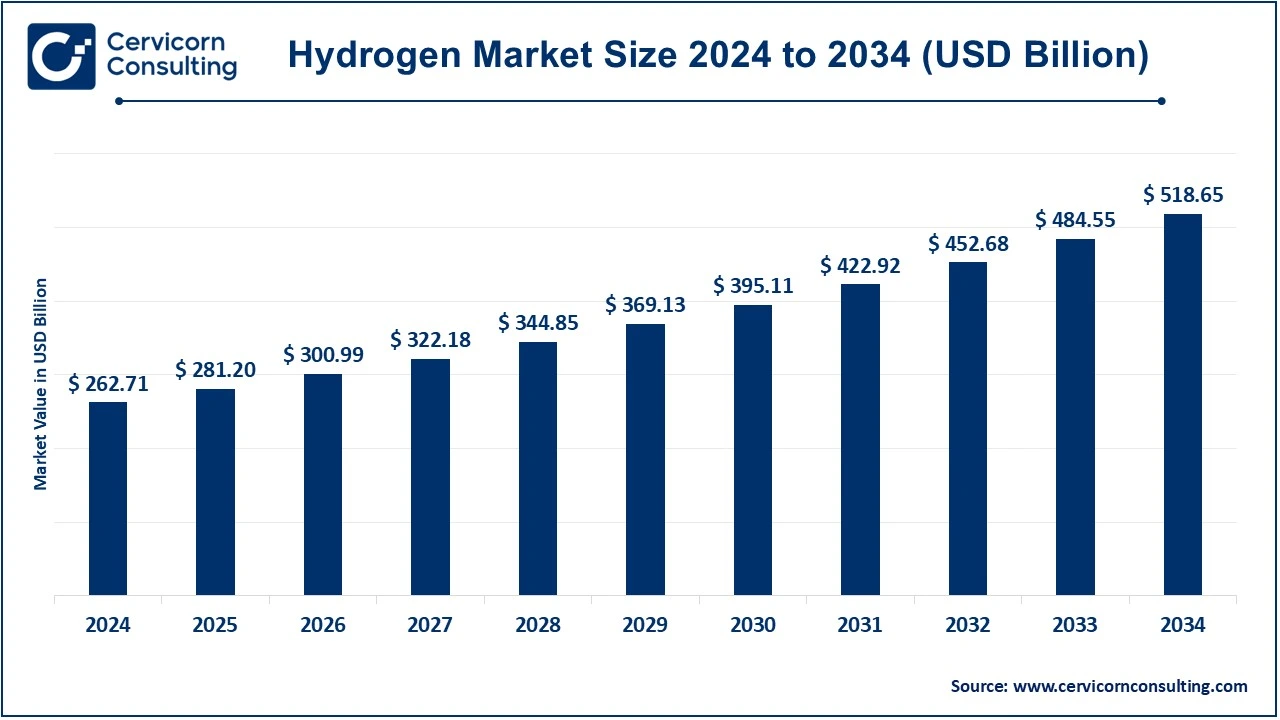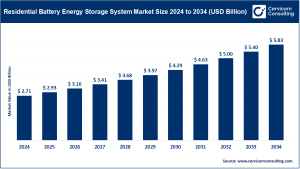Hydrogen Market Overview
The global hydrogen market was valued at around USD 262.71 billion in 2024 and is expected to exceed USD 518.65 billion by 2034, expanding at a CAGR of 7.03% from 2025 to 2034. Hydrogen, the lightest and most abundant element, is emerging as a versatile energy carrier with applications across transportation, power generation, and industrial sectors. Its uses range from fuel cells in vehicles to serving as feedstock for ammonia and methanol production. With increasing environmental concerns and the global push for carbon neutrality, hydrogen is playing a central role in the transition to clean energy.
Key Market Trends
-
Advancements in Electrolysis Technology
Innovations in electrolysis, including high-temperature systems and proton exchange membrane (PEM) technology, are making green hydrogen production more efficient, scalable, and cost-effective. These developments are crucial for supporting large-scale adoption of clean energy solutions. -
Rising Adoption of Hydrogen Fuel Cell Vehicles (FCVs)
Hydrogen-powered vehicles, particularly in heavy-duty transport, are witnessing accelerated uptake. By 2023, over 70,000 hydrogen fuel cell vehicles were sold globally, with Asia and Europe leading the growth trajectory. -
Expansion of Infrastructure
Significant investments by governments and private companies in hydrogen refueling stations, pipelines, and storage facilities are strengthening the supply chain, enabling wider mobility and industrial utilization. -
Regional Leadership in Hydrogen Technology
Europe, Japan, and the U.S. are at the forefront of hydrogen production, storage, and distribution innovation, implementing ambitious national strategies to integrate hydrogen into their energy ecosystems. -
Growth in Green Hydrogen Capacity
Global green hydrogen production capacity is projected to surge by 500% by 2030, reflecting the rising emphasis on renewable-powered hydrogen solutions.
Market Drivers
-
Government Policies and Incentives
Supportive measures, including subsidies, tax incentives, and clean energy mandates, are accelerating hydrogen adoption. Since 2020, global funding for hydrogen projects has surpassed USD 70 billion. -
Private Sector Investment
Energy companies, automotive manufacturers, and industrial players are investing heavily in hydrogen R&D, infrastructure, and production, aiming to capture emerging market opportunities. -
Demand in Hard-to-Decarbonize Industries
Sectors such as steel, chemicals, and heavy transport are increasingly utilizing hydrogen to reduce carbon emissions, with plans to replace up to 30% of fossil fuels with hydrogen by 2040. -
Long-Duration Energy Storage
Hydrogen offers a solution for long-term energy storage, complementing renewable energy systems. The energy storage market is projected to grow tenfold by 2035, further supporting hydrogen adoption.
Impact of Trends and Drivers
These market dynamics are influencing multiple segments:
-
The transportation sector is benefiting from expanded FCV adoption and enhanced refueling infrastructure.
-
Industrial applications are gaining access to low-carbon feedstock.
-
Regional adoption is strongest in Asia-Pacific (37.81% revenue share in 2024) and North America (30.16% revenue share), driven by supportive policies, industrial demand, and technological advancements.
-
Green hydrogen initiatives are significantly shaping global energy transition strategies.
Challenges & Opportunities
Challenges:
-
High production costs for green hydrogen
-
Limited infrastructure in certain regions
-
Technological scalability constraints
Opportunities:
-
Supportive government policies
-
Advancements in electrolyzer technology
-
Increasing industrial demand
-
Development of hydrogen valleys and integrated supply chains
Future Outlook
The hydrogen market is expected to continue its growth trajectory with ongoing investment in technology, infrastructure, and international collaborations. Green hydrogen is anticipated to dominate as nations prioritize sustainable energy. Innovations in electrolysis, fuel cell vehicles, and storage systems will remain central to market evolution over the next decade.

